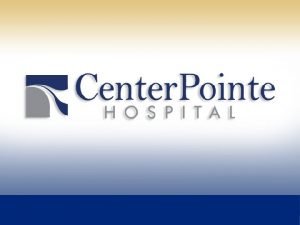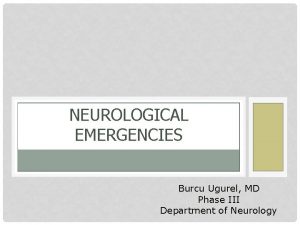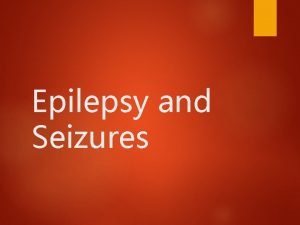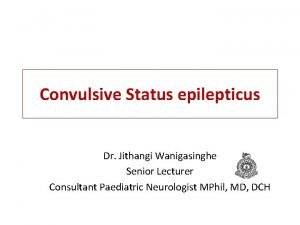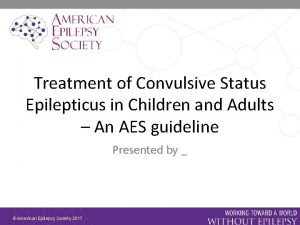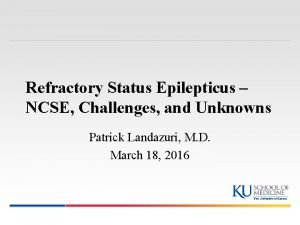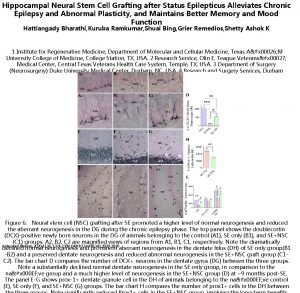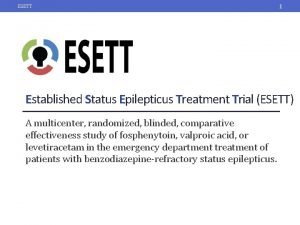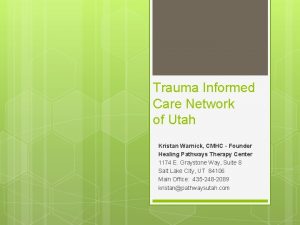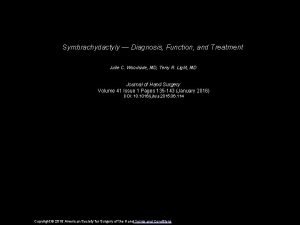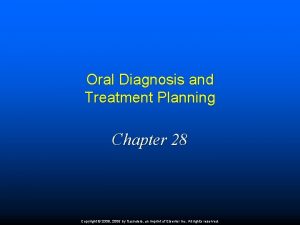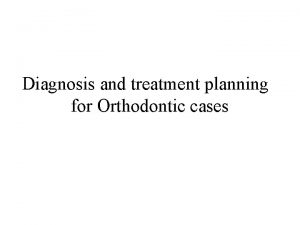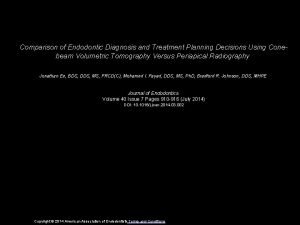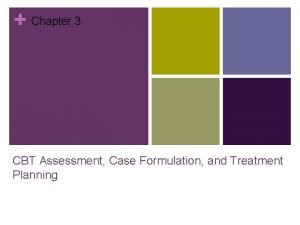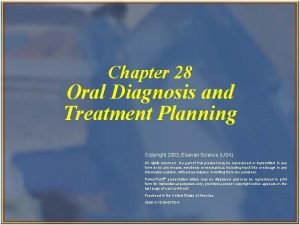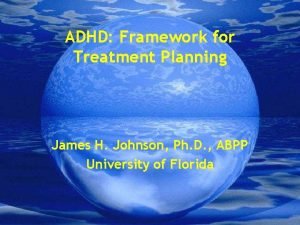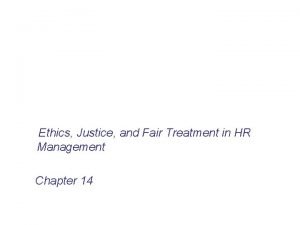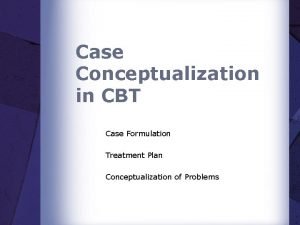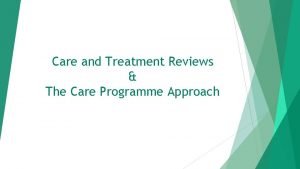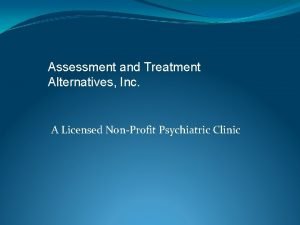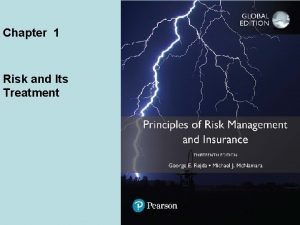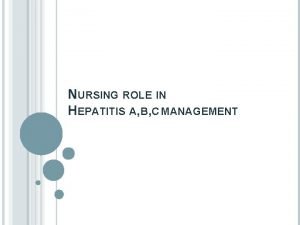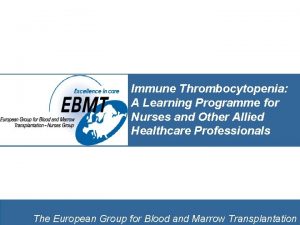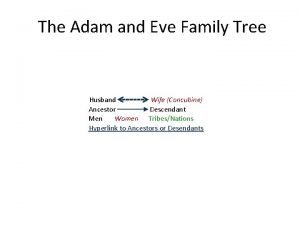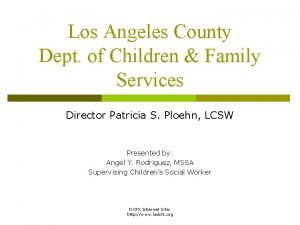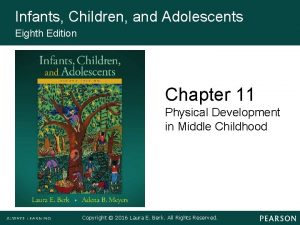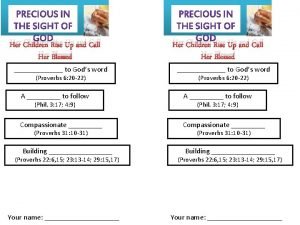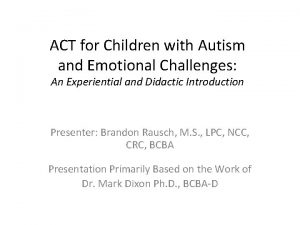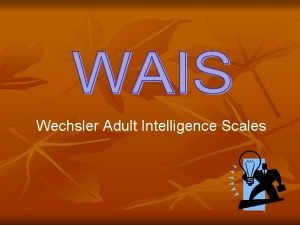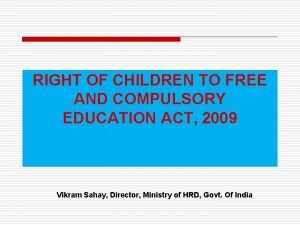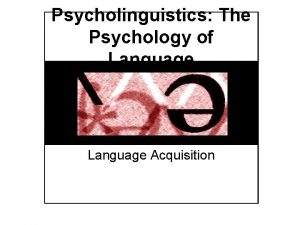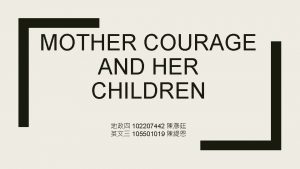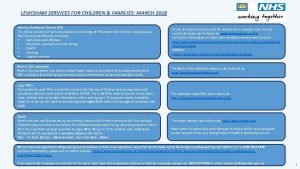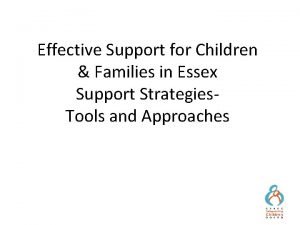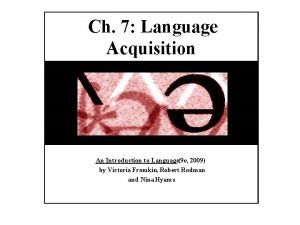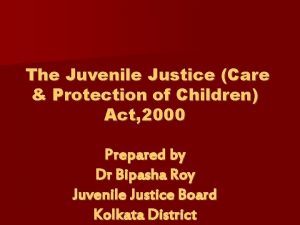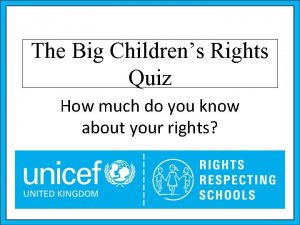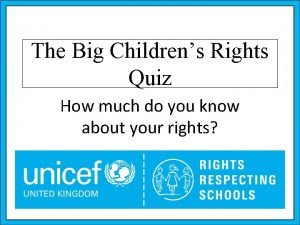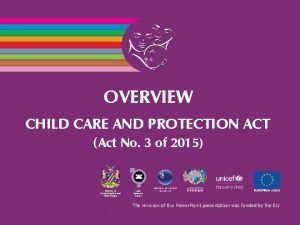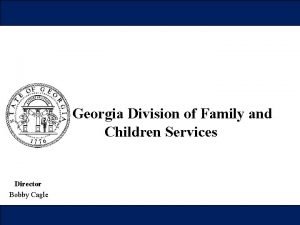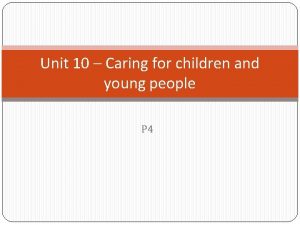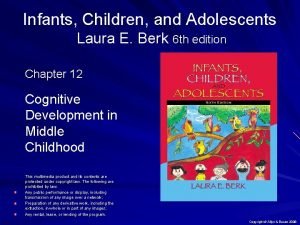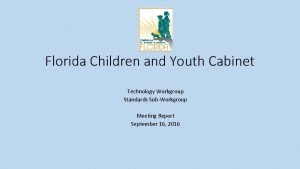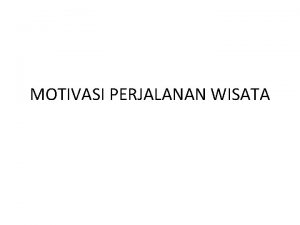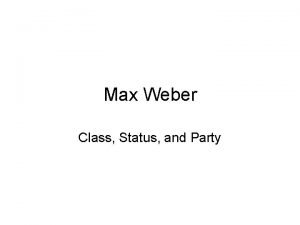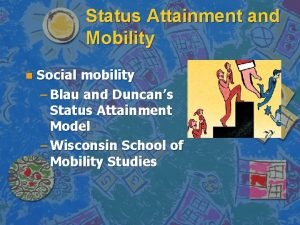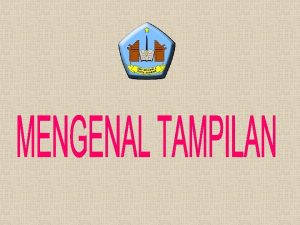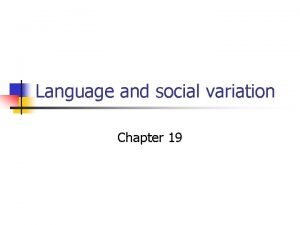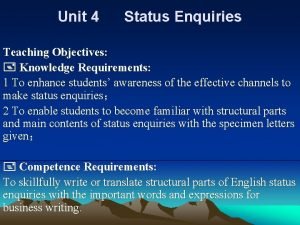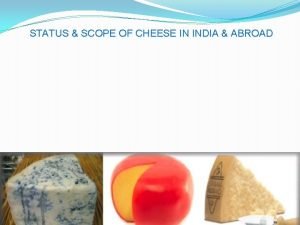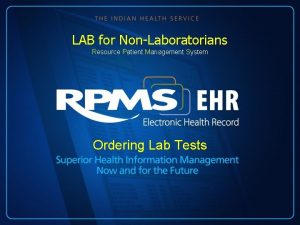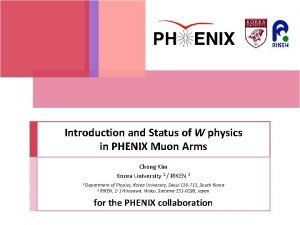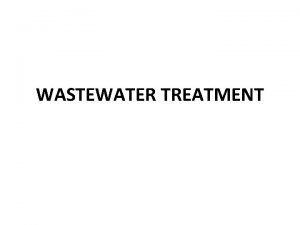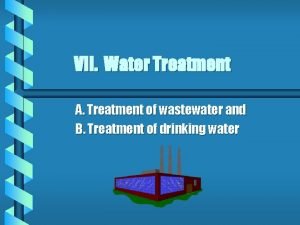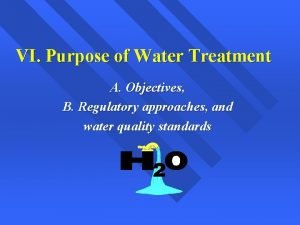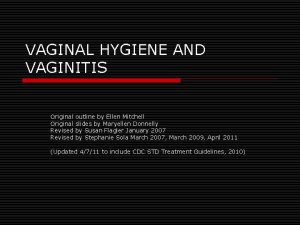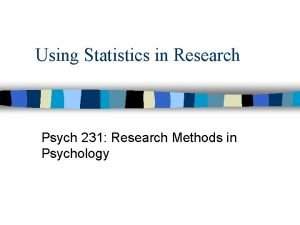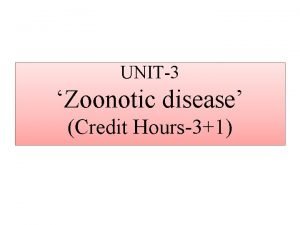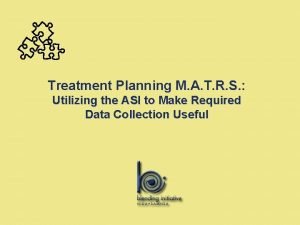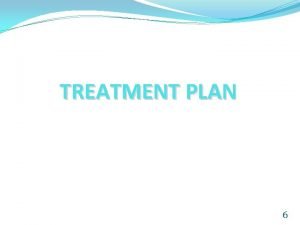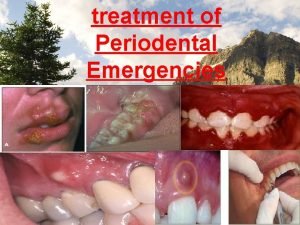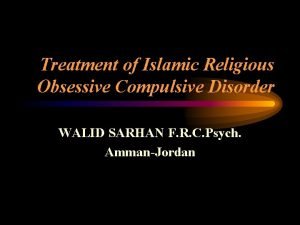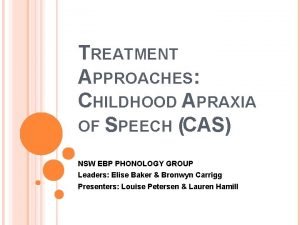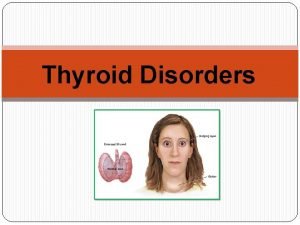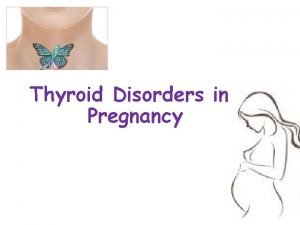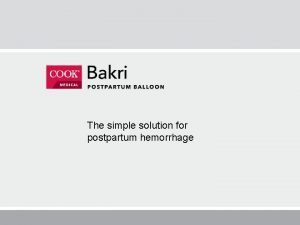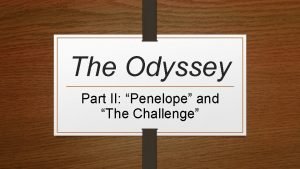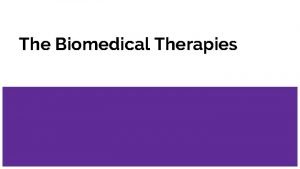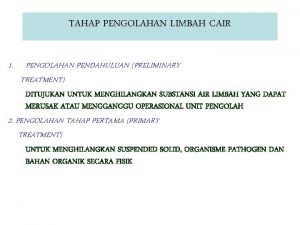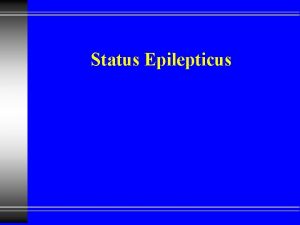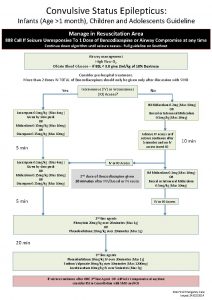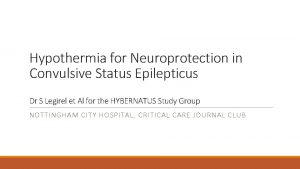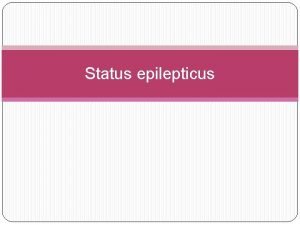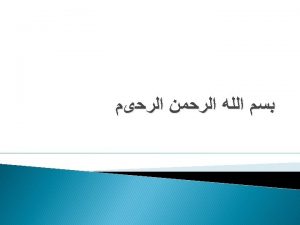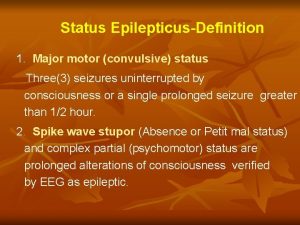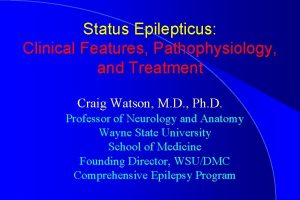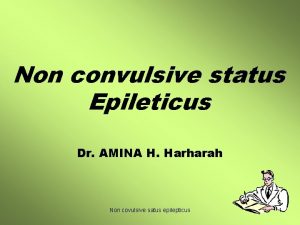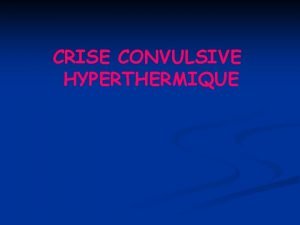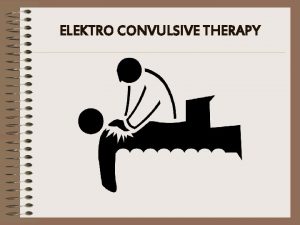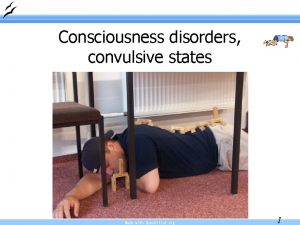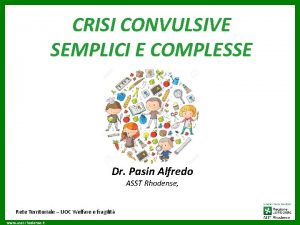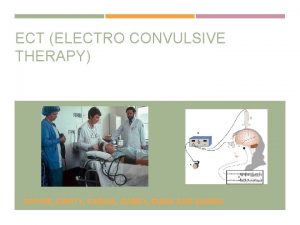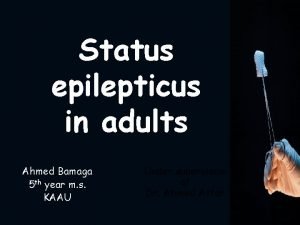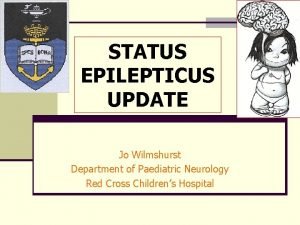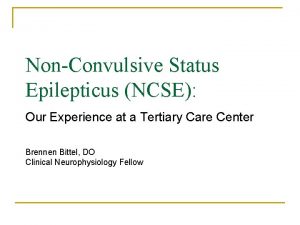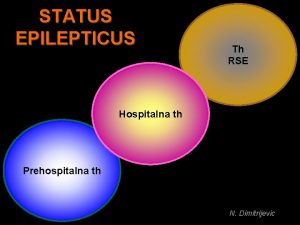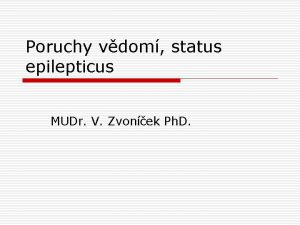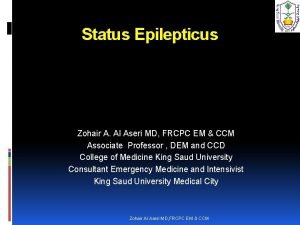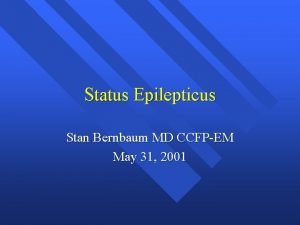Treatment of Convulsive Status Epilepticus in Children and




















































































- Slides: 84

Treatment of Convulsive Status Epilepticus in Children and Adults – An AES guideline Presented by _ © American Epilepsy Society 2017

Treatment of Convulsive Status Epilepticus BACKGROUND AND OVERVIEW

Background - Definitions • Brief seizures - less than 5 minutes • Prolonged seizures - between 5 and 30 minutes • Status epilepticus - more than 30 minutes of either 1) continuous seizure activity or 2) two or more sequential seizures without full recovery of consciousness between seizures 1

Background - Definitions • Status treatment protocols have used a 5 -minute definition – Minimizes risk of seizures reaching 30 minutes – Minimizes adverse outcomes associated with needlessly intervening on brief, self-limited seizures • This guideline uses the term status epilepticus to represent studies involving both prolonged seizures and traditionally defined status epilepticus 2

Background – Forms of Status • Convulsive status epilepticus (CSE) Repeated generalized tonic–clonic (GTC) seizures with persistent postictal depression of neurologic function between seizures • Nonconvulsive status epilepticus • Repeated partial seizures manifested as focal motor signs, focal sensory symptoms, or focal impairment of function (e. g. , aphasia) not associated with altered awareness (epilepsia partialis continua)

Background – Epidemiology of Status • Between 50, 000 and 150, 000 Americans each year have status epilepticus • Mortality estimated at less than 3% in children but up to 30% in adults • The goal of therapy is the rapid termination of both clinical and electrical seizure activity - appropriate and timely therapy of status epilepticus reduces the associated mortality and morbidity. • Prognosis is most strongly related to the etiology, duration of status epilepticus, and the age of the patient.

Background – Guideline Rationale • Basic critical care and emergency principles of therapy are generally agreed upon and routinely implemented by both neurologists and nonneurologists (supporting respiration, maintaining blood pressure, gaining intravenous access, and identifying and treating the underlying cause) • However goals of therapy and approaches to the pharmacologic treatment of status epilepticus continue to vary dramatically 1

Background – Guideline Rationale • Patients receive inadequate treatment for a variety of reasons including – therapy aimed at reduction instead of termination of seizures – use of inefficient therapies such as sedatives and paralytics – administration of insufficient anticonvulsant doses – delay in initiating and escalating treatment • Clinical trials demonstrate differences in efficacy • Previous guidelines were consensus/expert based not evidence based with a treatment algorithm 2

Background of this guideline • In 1993, the Epilepsy Foundation of America developed an expert consensus treatment document depicting the best current medical management of convulsive status epilepticus. • Over the past 2 decades, new medical therapies and new clinical trial data have emerged relating directly to the treatment of this most feared type of seizure activity. • Coupled with the acceptance of evidence-based rather than consensus-based guidelines, the Epilepsy Foundation in 2004 and the American Epilepsy Society in 2012 began the process of reevaluating the existing medical literature and developing a new guideline.

Treatment of Convulsive Status Epilepticus GUIDELINE OVERVIEW

Guideline Goals, Focus • Goal #1: Provide evidence-based answers to efficacy, safety, and tolerability questions regarding the treatment of convulsive status epilepticus • Goal #2: Synthesize these answers into a treatment algorithm. • Focus is on convulsive status epilepticus since it is the most common type of status epilepticus and is associated with substantial morbidity and mortality.

Definitions • Efficacy = ability of the drug to stop convulsive status epilepticus • Tolerability = the “incidence, severity and impact” of AED related adverse effects • Effectiveness = both anticonvulsant efficacy and tolerability, • Safety = life-threatening adverse events

Guideline Scope • Only studies that enrolled subjects having a seizure duration of ≥ 5 minutes. • Studies presented by subject age (adult studies, pediatric studies), since studies arbitrarily focused on either adult or pediatric subjects. • Treatment algorithm is not age specific since 1) the disease pathophysiology of prolonged seizures and status epilepticus and 2) anticonvulsant drug effects on neuronal receptors are the same from infants through adults. 1

Guideline Scope • Not examined: – Treatment of refractory status epilepticus or neonatal status epilepticus – Subsequent chronic anticonvulsant therapy – Etiology-specific therapy (e. g. , for cerebral malaria) – Role of different diagnostic tests (e. g. , EEG, CT, MRI) – Role of epilepsy surgery, neurostimulation, or the ketogenic diet – Cost effectiveness of economic analyses 2

Methods – Part 1 • Methodology was specified before the searches were conducted • Approach integrated methods used by the American Academy of Neurology and the International League Against Epilepsy. • MEDLINE and Current Contents were searched for relevant articles published between January 1940 and September 2014 (inclusive). 1

Methods – Part 1 • The entire Cochrane Library was serially searched (last in April 2015). • Studies were considered potentially relevant if they included – the term “status epilepticus, ” – examined anticonvulsant efficacy, safety, tolerability, or mode of use, – were a randomized controlled trial (RCT), cohort study, case control study, observational study, case series, metaanalysis, or systematic review. 2

Methods – Part 2 • Each potentially relevant study was abstracted for specific data which were placed in evidence tables for further analysis. • The review panel consisted of a group of neurologists, neurology nurses, emergency medicine physicians, clinical pharmacists, methodologists, and neurocritical care physicians with experience in status epilepticus and anticonvulsants.

Methods – Part 3 • Scoring integrating the system used by the United States Agency for Health Care and Policy Research and the American Academy of Neurology scoring system with 2 modifications: – A 10% noninferiority margin between test drug and comparator drug was considered to be clinically appropriate for noninferiority analyses (per-protocol analysis) and failed superiority studies – Fewer class I or II studies were needed to reach a Level A or B recommendation than for other neurologic conditions because of the challenges in conducting randomized, controlled, double-blind, status epilepticus studies.

Rating of Articles • Class I: Prospective, randomized, controlled clinical trial with masked outcome assessment in a representative population. The following are also required: • No more than two primary outcomes specified • Concealed allocation • Exclusion/inclusion criteria clearly defined • Relevant baseline characteristics presented and substantially equivalent between treatment groups, or appropriate statistical adjustment for differences 1

Rating of Articles • Class I (con’t): • Adequate accounting for dropouts (with at least 80% of enrolled subjects completing the study) with numbers sufficiently low to have minimal potential for bias • Demonstration of superiority in a superiority study design or demonstration of noninferiority using a 10% margin in a noninferiority design (per-protocol analysis) 2

Rating of Articles • Class II: A prospective, randomized, controlled clinical trial with masked outcome assessment that lacks one or two criteria a–e (see class I) or a prospective matched group cohort study in a representative population with masked outcome assessment that meets criteria a–e

Rating of Articles • Class III: All other controlled trials in a representative population, where outcome is independently assessed, or independently derived by objective outcome measurements • Class IV: Evidence from uncontrolled studies, case series, case reports, or expert opinion

Translation of Article Ratings: Conclusions & Recommendations Rating Level A rating: ≥ 1 class I studies or ≥ 2 consistent class II studies Level B rating: ≥ 1 class II studies or ≥ 3 consistent class III studies Conclusion and Recommendation Conclusion: Established as effective, ineffective, or harmful for the given condition in the specified population Recommendation: Should be done or should not be done Conclusion: Probably effective, ineffective, or harmful for the given condition in the specified population Recommendation: Should be considered or should not be considered Level C rating: Conclusion: Possibly effective, ineffective, or harmful for ≥ 2 consistent class III studies the given condition in the specified population Recommendation: May be considered or may not be considered Level U: Conclusion: Data inadequate or insufficient. Given current Lack of studies meeting level A, knowledge, treatment is unproven. B, or C designation Recommendation: None

Methods - Five questions (adults/children with seizures ≥ 5 minutes) Q 1. Which anticonvulsants are efficacious as initial and subsequent therapy? Q 2. What adverse events are associated with anticonvulsant administration? Q 3. Which is the most effective benzodiazepine? Q 4. Is IV fosphenytoin more effective than IV phenytoin? Q 5. When does anticonvulsant efficacy drop significantly (i. e. , after how many different anticonvulsants does status epilepticus become refractory)?

Overall Search Results • 38 relevant RCTs were identified. • Cochrane Library yielded four additional completed and relevant published meta-analyses. • Pharmaceutical companies provided requested additional information on three RCTs.

Results - Five questions Q 1. Which anticonvulsants are efficacious as initial and subsequent therapy? Adult: 9 RCTs (three class I, one class II, and five class III ) Pediatric : 26 RCTs (two class I, 24 class III) Q 2. What adverse events are associated with anticonvulsant administration? Adult: 4 RCTs (three class I, one class II) Pediatric : 19 RCTs (class I, 18 class III) Q 3. Which is the most effective benzodiazepine? Adult: 4 RCTs (three class I, one class II) Pediatric : 1 RCT (1 class I) and one meta-analysis Q 4. Is IV fosphenytoin more effective than IV phenytoin? Adult: 3 RCTs (three class III ) Q 5. When does anticonvulsant efficacy drop significantly (i. e. , after how many different anticonvulsants does status epilepticus become refractory)? Adult: 1 RCTs (one class I)

Treatment of Convulsive Status Epilepticus Q 1: EFFICACY STUDIES

Q 1: Class 1 (adult) - 1998 Veteran’s Affairs SE study • 570 adult patients with either overt or subtle status epilepticus randomized to one of four different IV treatments: – – lorazepam (0. 1 mg/kg) (n=146) diazepam (0. 15 mg/kg) followed by phenytoin (18 mg/kg) (n=146) phenobarbital (18 mg/kg) (n=133) phenytoin alone (18 mg/kg) (n=145) • Overt status epilepticus was defined as a continuous GTC seizure lasting 10 minutes or longer, or two or more GTC seizures without full recovery of consciousness.

Q 1: Class 1 (adult) – 1998 Veteran’s Affairs SE study • Success: status epilepticus stopped within 20 minutes after infusion started with no recurrence prior to 60 minutes. • Differential anticonvulsant efficacy was found in overt status epilepticus where the four treatment arms had an overall difference (p = 0. 02) for the primary outcome variable. • Only one head-to head comparison met the pre-specified statistical significance difference: lorazepam was superior to phenytoin (p = 0. 002) • There was no difference on the intent to treat (ITT) analysis (22).

Q 1: Class I (adult) – 2001 Alldredge trial • 205 adult patients with status epilepticus randomized to one of 3 different treatments initiated outside the hospital by paramedics: – IV lorazepam (2 mg, n=66) – IV diazepam (5 mg, n=68) – IV placebo (n=71) • A repeat dose of study drug could be done if the seizure continued after 4 minutes (for a maximum lorazepam dose of 4 mg and diazepam dose of 10 mg)

Q 1: Class I (adult) – 2001 Alldredge trial • Status epilepticus was defined as continuous or repeated seizure for >5 minutes without recovery of consciousness. • Success: Status epilepticus had terminated at the time of arrival in the ED. • Both lorazepam and diazepam were superior to placebo: lorazepam (59. 1%) > placebo (21. 1%) (OR, 4. 8; 95% CI: 1. 9– 13. 0) diazepam (42. 6%) > placebo (21. 1%) (OR, 2. 3; 95% CI: 1. 0– 5. 9)

Q 1: Class 1 (adult and child) - 2012 RAMPART study • 893 participants with SE (748 adults and 145 children) were randomized to one of two treatments in a non-inferiority comparison (pre-specified non-inferiority margin of 10%): – Intramuscular midazolam (10 mg or 5 mg in children weighing 13– 40 kg, n=448) – IV lorazepam (4 mg or 2 mg in children weighing 13– 40 kg, n=445) • Status epilepticus was defined as convulsions persisting for > 5 minutes that were still occurring after paramedic arrival

Q 1: Class 1 (adult and child) - 2012 RAMPART study • Success: Absence of seizures without additional rescue therapy at time of arrival in the emergency department. • Primary efficacy endpoint was achieved in 73% of subjects in the IM midazolam group compared with 63% in the IV lorazepam group giving an absolute difference between groups of 10% (95% CI: 4. 0– 16. 1) Pre-specified non-inferiority requirement was met Demonstrated superiority of midazolam for both the per protocol and ITT analyses in patients without established IV access

Q 1: Class II (adult) - 1983 Leppik study • 70 adults with convulsive status epilepticus (defined as ≥ 3 GTC seizures in 1 hour or ≥ 2 in rapid succession), absence status epilepticus, or complex partial status epilepticus were randomized to one of two treatments : – IV lorazepam (4 mg, n=37) – IV diazepam (10 mg, n=33) • A second dose of medication could be given if the seizures continued after 10 minutes

Q 1: Class II (adult) - 1983 Leppik study • For all patients, phenytoin was given after 30 minutes • Lorazepam was successful for 78% of subjects after one dose and 89% after two doses; diazepam was successful for 58% of subjects after one dose and 76% after two doses • The study found no statistically significant difference between lorazepam and diazepam in seizure cessation after one or two medication administrations

Q 1: Class III adult studies • IV valproic acid (n = 2), IV phenytoin (n = 2), IV phenobarbital (n = 1), IV diazepam plus phenytoin (n = 1), IV levetiracetam (n = 1), rectal diazepam (n = 1), and IV lorazepam (n = 1) in cohorts ranging from 9 to 41 patients. • Valproic acid had higher efficacy than phenytoin in one study (valproic acid, 66%, vs phenytoin, 42%; p = 0. 046) and was similar to phenytoin in the other (valproic acid, 87. 8%, vs phenytoin, 88%) • Two RCTs addressed second-therapy efficacy in adults after failure of initial benzodiazepine therapy. – Intravenous valproic acid’s efficacy was similar to IV phenytoin (88% vs 84%) – Intravenous valproic acid’s efficacy was similar to continuous IV diazepam (56% vs 50%)

Q 1: Class I (adult): VA study second monotherapy • Each arm of the Veterans Affairs status epilepticus study had a second blinded treatment if initial therapy was unsuccessful: – – IV lorazepam therapy was followed by IV phenytoin IV phenobarbital was followed by IV phenytoin was followed by IV lorazepam IV diazepam plus IV phenytoin was followed by IV lorazepam • There was no difference in efficacy between the four treatment arms when initial and second therapies together were examined

Q 1: Adult studies efficacy conclusions • IM midazolam, IV lorazepam, IV diazepam (with or without phenytoin), and IV phenobarbital are established as efficacious at stopping seizures lasting at least 5 minutes (level A). • IM midazolam has superior effectiveness compared with IV lorazepam in adults with convulsive status epilepticus without established IV access (level A). • IV lorazepam is more effective than IV phenytoin in stopping seizures lasting at least 10 minutes (level A).

Q 1: Adult studies efficacy conclusions • There is no difference in efficacy between IV lorazepam followed by IV phenytoin, IV diazepam plus phenytoin followed by IV lorazepam, and IV phenobarbital followed by IV phenytoin (level A). • IV valproic acid has similar efficacy to IV phenytoin or continuous IV diazepam as second therapy after failure of a benzodiazepine (level C). • Insufficient data exist in adults about the efficacy of levetiracetam as either initial or second therapy (level U).

Q 1: Class I (child) - Chamberlain study • 273 children (aged 3 months to 18 years) were randomized to either – IV diazepam 0. 2 mg/kg (maximum dose 8 mg, n=140) – IV lorazepam 0. 1 mg/kg (maximum dose 4 mg, n=133) • If seizures continued after 5 more minutes, then half of the initial study drug dose could be repeated. If seizures continued another 7 more minutes, then fosphenytoin was given. • Success: termination of status epilepticus by 10 minutes without reappearance within 30 minutes

Q 1: Class I (child) - Chamberlain study • No difference between treatment arms for successful outcome – IV diazepam (101/140, 72. 1%) – IV lorazepam (97/133, 72. 9%) Absolute difference of 0. 8%, 95% CI: − 11. 4– 9. 8% • Conclusion: no evidence to support the hypothesis that lorazepam was superior to diazepam as initial therapy for pediatric status epilepticus

Q 1: Class I (child) - RAMPART study • 120 children with SE were randomized to one of two treatments in a non-inferiority comparison (pre-specified noninferiority margin of 10%): – Intramuscular midazolam (10 mg or 5 mg in children weighing 13– 40 kg, n=60) – IV lorazepam (4 mg or 2 mg in children weighing 13– 40 kg, n=60) • Status epilepticus was defined as convulsions persisting for > 5 minutes that were still occurring after paramedic arrival

Q 1: Class I (child) - RAMPART study • Success: Absence of seizures without additional rescue therapy at time of arrival in the emergency department. • No statistical difference in efficacy was found between the IM midazolam (68. 3%) and IV lorazepam (71. 7%), but the relatively few children studied results in wide confidence intervals preventing any firm conclusions

Q 1: Class III (child)- Benzodiazepine studies • The class III benzodiazepine RCTs involved diazepam (n = 20), midazolam (n = 16), and lorazepam (n = 6). The different routes of administration included IV (n = 13), rectal (n = 10), intranasal (n = 9), buccal (n = 6), IM (n = 3), and sublingual (n = 1). • The size of the studies ranged from 24 patients to 436 patients. • Although all studies were prospective and randomized, they were class III because treating physicians were either not blinded to treatment allocation or lacked outcome masking (meaning the outcome assessors were not blinded to treatment allocation)

Q 1: Pediatric study efficacy conclusions • In children, IV lorazepam and IV diazepam are established as efficacious at stopping seizures lasting at least 5 minutes (level A). • Rectal diazepam, IM midazolam, intranasal midazolam, and buccal midazolam are probably effective at stopping seizures lasting at least 5 minutes (level B). • Insufficient data exist in children about the efficacy of intranasal lorazepam, sublingual lorazepam, rectal lorazepam, valproic acid, levetiracetam, phenobarbital, and phenytoin as initial therapy (level U).

Q 1: Pediatric study efficacy conclusions • Intravenous valproic acid has similar efficacy but better tolerability than IV phenobarbital (level B) as second therapy after failure of a benzodiazepine. • Insufficient data exist in children regarding the efficacy of phenytoin or levetiracetam as second therapy after failure of a benzodiazepine (level U).

Treatment of Convulsive Status Epilepticus Q 2: ADVERSE EVENTS IN ADULT SE INITIAL THERAPY

Q 2: Adverse Events in Adult SE initial therapy • 1998 class I Veterans Affairs SE study: No significant differences in adverse-event rates between lorazepam, diazepam, phenobarbital, and phenytoin. IV lorazepam IV diazepam plus IV phenytoin IV phenobarbital IV phenytoin Hypoventilation Hypotension Cardiac rhythm disturbance 10. 3% 16. 8% 13. 2% 9. 9% 25. 8% 31. 6% 34. 1% 27. 0% 7. 2% 2. 1% 3. 3% 6. 9%

Q 2: Adverse Events in Adult SE initial therapy • 2001 Class I prehospital SE study – treatment emergent adverse events (hypotension, cardiac dysrhythmia, respiratory intervention): IV lorazepam - 10. 6% IV diazepam - 10. 3% Placebo – 22. 5% (p = 0. 08)

Q 2: Adverse Events in Adult SE initial therapy (con’t) • 2012 class I RAMPART trial treatment-emergent adverse events Overall: IM midazolam, 26. 7% vs. IV lorazepam, 30. 6% Decreased level of consciousness: IM midazolam, 9. 5%, vs IV lorazepam, 8. 8% Respiratory depression: IM midazolam, 6. 4%, vs IV lorazepam, 10% Hypotension: 1. 2% of subjects overall • 1983 Class II Leppik study treatment-emergent adverse events including respiratory depression, respiratory arrest, hypotension, and sedation IV lorazepam 12% IV diazepam 13%

Q 2: Adult studies adverse event conclusions • Respiratory and cardiac symptoms are the most common encountered treatment-emergent adverse events associated with IV anticonvulsant administration in adults with status epilepticus (level A). • The rate of respiratory depression in patients with status epilepticus treated with benzodiazepines is lower than in patients with status epilepticus treated with placebo (level A), indicating that respiratory problems are an important consequence of untreated status epilepticus. • No substantial difference exists between benzodiazepines and phenobarbital in the occurrence of cardiorespiratory adverse events in adults with status epilepticus (level A).

Treatment of Convulsive Status Epilepticus Q 2: ADVERSE EVENTS IN PEDIATRIC SE INITIAL THERAPY

Q 2: Adverse Events in Pediatric SE initial therapy • Class I (child) - Chamberlain study 273 children (aged 3 months to 18 years) were randomized to either – IV diazepam 0. 2 mg/kg (maximum dose 8 mg, n=140) – IV lorazepam 0. 1 mg/kg (maximum dose 4 mg, n=133) IV lorazepam IV diazepam Absolute risk difference 95% CI Assisted ventilation Aspiration pneumonia Sedation 17. 6% 16. 0% 1. 6% − 9. 9– 6. 8% N=2 66. 9% 50% 16. 9% 6. 1– 27. 7%

Q 2: Pediatric studies adverse event conclusions • Respiratory depression is the most common clinically significant treatment-emergent adverse event associated with anticonvulsant drug treatment in status epilepticus in children (level A). • No substantial difference probably exists between midazolam, lorazepam, and diazepam administration by any route in children with respect to rates of respiratory depression (level B). • Adverse events, including respiratory depression, with benzodiazepine administration for status epilepticus have been reported less frequently in children than in adults (level B).

Treatment of Convulsive Status Epilepticus Q 3: WHICH IS THE MOST EFFECTIVE BENZODIAZEPINE IN ADULTS?

Q 3: Which Is the Most Effective Benzodiazepine in Adults? • 2001 Class I prehospital SE study – Success with IV lorazepam was higher but not significantly different than with diazepam (odds ratio [OR], 1. 9; 95% CI: 0. 8– 4. 4). – However, the study’s sample size was selected to be able to detect a difference between the active drugs and placebo, not to detect a difference between the two active drugs (23). • 1983 Class II Leppik study treatment – No difference between the two arms in the percentage of patients having control of seizures after either one injection (lorazepam, 78%; diazepam, 58%; not significant [NS]) or two injections (lorazepam, 89%; diazepam, 76%; NS). – There was no significant difference between the two arms in the latency of action (lorazepam median, 3 minutes; diazepam median, 2 minutes; NS)

Q 3: Which Is the Most Effective Benzodiazepine in Adults? • 2012 class I RAMPART trial – Success for IM midazolam > IV lorazepam group (73% vs. 63%, resulting in an absolute difference of 10% (95% CI: 4. 0– 16. 1; p < 0. 001). This met the pre-specified non-inferiority requirements plus additional superiority for both per protocol and ITT analyses. – Median time from active treatment to cessation of convulsions was shorter for IV lorazepam (1. 6 minutes) compared with IM midazolam (3. 3 minutes), which was offset by more rapid IM midazolam administration (IV lorazepam, 4. 8 minutes, vs intranasal midazolam, 1. 2 minutes).

Q 3: Which Is the Most Effective Benzodiazepine in Adults? • There is no difference in the treatment-emergent adverse event profiles between lorazepam and diazepam in the three adult class I and class II status epilepticus studies. • No differences in treatment-emergent adverse-event profiles were found between IM midazolam and IV lorazepam. • There is pharmacokinetic evidence to suggest a longer duration of action (but not longer half-life) for lorazepam compared with diazepam.

Q 3: Most effective benzodiazepine in adults - conclusions • The following conclusions were drawn. In adults with status epilepticus without established IV access, IM midazolam is established as more effective compared with IV lorazepam (level A). • No significant difference in effectiveness has been demonstrated between lorazepam and diazepam in adults with status epilepticus (level A).

Treatment of Convulsive Status Epilepticus Q 3: WHICH IS THE MOST EFFECTIVE BENZODIAZEPINE IN CHILDREN?

Q 3: Which Is the Most Effective Benzodiazepine in Children? • Class I (child) - Chamberlain study Efficacy was similar between IV diazepam (101/140, 72. 1%) and IV lorazepam (97/133, 72. 9%). Side-effect profiles of the two treatments were similar. • A meta-analysis of six class III pediatric studies found Non-IV midazolam (IM/intranasal/buccal) was more effective than diazepam (IV/rectal) at achieving seizure cessation (relative risk [RR] =1. 52, 95% CI: 1. 27– 1. 82) with similar respiratory complications (RR = 1. 49; 95% CI: 0. 25– 8. 72).

Q 3: Which Is the Most Effective Benzodiazepine in Children? • Time to seizure cessation was shorter for IN midazolam compared with IV diazepam in two Class III studies and longer in one Class III study. • IN midazolam vs. rectal diazepam: IM midazolam was more effective in terminating seizures and demonstrated a shorter time to seizure termination. • IM midazolam vs. IV diazepam, a shorter interval to seizure cessation was found for IM midazolam in two Class III studies.

Q 3: Most effective benzodiazepine in children - conclusions • In children with status epilepticus, no significant difference in effectiveness has been established between IV lorazepam and IV diazepam (level A). • In children with status epilepticus, non-IV midazolam (IM/intranasal/buccal) is probably more effective than diazepam (IV/rectal) (level B).

Treatment of Convulsive Status Epilepticus Q 4: IS IV FOSPHENYTOIN MORE EFFECTIVE THAN IV PHENYTOIN?

Q 4: Is IV Fosphenytoin More Effective Than IV Phenytoin? Hanna DR. J Neurosci Nur. 1992; 24: 340 -345.

Q 4: Is IV Fosphenytoin More Effective Than IV Phenytoin? • A Class III single-dose, randomized, double-blind, class III tolerability study in patients needing infusion of phenytoin compared Fosphenytoin (n = 39, 12. 7 mg/kg, 82 mg phenytoin equivalent [PE]/min [range, 40– 103 mg PE/min]) Phenytoin (n = 13, 11. 3 mg/kg, 42. 4 mg/min) No fosphenytoin-related significant cardiac arrhythmias, change in heart rate, respiration or blood pressure.

Q 4: Is IV Fosphenytoin More Effective Than IV Phenytoin? • A Class III randomized, double-blind, tolerability study involved patients requiring a phenytoin loading dose and then 3 to 14 days of maintenance therapy compared Fosphenytoin (n = 88, 15. 3 mg/kg, 37 mg PE/min) Phenytoin (n = 28, 15. 0 mg/kg, 33 mg/min) Pain at the infusion site was greater for phenytoin than fosphenytoin (17% vs 2%).

Q 4: Is IV Fosphenytoin More Effective Than IV Phenytoin? • A Class III single-dose, randomized, double-blind, study compared – Fosphenytoin at 150 mg PE/min (n = 90) – Phenytoin at 50 mg/min (n = 22) – The infusion was slowed or discontinued more often with IV phenytoin compared with IV fosphenytoin – 63. 6% of phenytoin patients experienced pain at site of infusion – 48. 6% of fosphenytoin patients encountered pruritus – Average blood pressure decrease with fosphenytoin was 13. 7 mm Hg compared with 5. 9 mm Hg with phenytoin

Q 4: IV Fosphenytoin vs. IV Phenytoin - conclusions • Insufficient data exist about the comparative efficacy of phenytoin and fosphenytoin (level U). • Fosphenytoin is better tolerated compared with phenytoin (level B). • When both are available, fosphenytoin is preferred based on tolerability, but phenytoin is an acceptable alternative (level B).

Treatment of Convulsive Status Epilepticus Q 5: WHEN DOES ANTICONVULSANT EFFICACY DROP SIGNIFICANTLY

Q 5: When Does Anticonvulsant Efficacy Drop Significantly (i. e. , After How Many Different Anticonvulsants Does Status Epilepticus Become Refractory)? • Only the 1998 class I Veterans Affairs SE study provides clear data: Four-arm double-blind RCT. In order to maintain the blinding, if the first administered anticonvulsant was not successful, then the patient was randomized to a second treatment arm; if that was not successful, then the patient was randomized to a third treatment arm. Treatment success defined as status epilepticus stopping within 20 minutes after infusion started with no recurrence prior to 60 minutes after the start of the infusion. In adults with overt status epilepticus overall success rate of 62% (237/384).

Q 5: When Does Anticonvulsant Efficacy Drop Significantly (i. e. , After How Many Different Anticonvulsants Does Status Epilepticus Become Refractory)? • The efficacy of each successive blinded treatment was: First AED 55. 5% Second AED 7. 0% Third AED 2. 3% Four or more AEDs 23. 2% No AED was successful 11. 7% • If the patient did not respond to lorazepam or phenytoin, the response rate to phenobarbital was 2. 1%

Q 5: When Does Anticonvulsant Efficacy Drop Significantly? - conclusions • In adults, the second anticonvulsant administered is less effective than the first “standard” anticonvulsant, while third anticonvulsant administered is substantially less effective than the first “standard” anticonvulsant (level A). • In children, the second anticonvulsant appears less effective, and there are no data about third anticonvulsant efficacy (level C).

Treatment of Convulsive Status Epilepticus TREATMENT ALGORITHM

Treatment Algorithm for Convulsive Status Epilepticus Stabilization phase 0 to 5 minutes • Unified approach across age groups: The guideline’s treatment algorithm is not age specific because the disease pathophysiology of prolonged seizures/status epilepticus and anticonvulsant drug effects on neuronal receptors are the same from infants through adults. • Standard initial first aid should be provided during the first five minutes of a seizure - the stabilization phase (0– 5 minutes).

Treatment Algorithm for Convulsive Status Epilepticus Initial therapy phase 5 to 20 minutes • When the seizure duration reaches 5 minutes initial therapy phase should begin. • A benzodiazepine (specifically IM midazolam, IV lorazepam, or IV diazepam) is recommended as the initial therapy of choice (level A, four class I RCTs). Although IV phenobarbital is established as efficacious and well tolerated as initial therapy (level A, 1 class I RCT), its slower rate of administration, compared with the three recommended benzodiazepines above, positions it as an alternative initial therapy. For prehospital settings or where three firstline benzodiazepine options are not available, rectal diazepam, intranasal midazolam, and buccal midazolam are reasonable initial therapy alternatives (level B).

Treatment Algorithm for Convulsive Status Epilepticus Initial therapy phase 5 to 20 minutes • Initial therapy should be administered as an adequate single full dose rather than broken into multiple smaller doses. Initial therapies should not be given twice except for IV lorazepam and diazepam that can be repeated at full doses once (level A, two class I, one class II RCT). Doses listed in the initial therapy phase are those used in class I trials. Some consensus guidelines list slightly different dosages; for example, phenobarbital is often recommended at 20 mg/kg.

Treatment Algorithm for Convulsive Status Epilepticus Second therapy phase 20 to 40 minutes • The second-therapy phase should begin when the seizure duration reaches 20 minutes and should conclude by the 40 -minute mark when response (or lack of response) to the second therapy should be apparent. • Reasonable options include fosphenytoin (level U), valproic acid (level B, one class II study) and levetiracetam (level U). • There is no clear evidence that any one of these options is better than the others.

Treatment Algorithm for Convulsive Status Epilepticus Second therapy phase 20 to 40 minutes • The ongoing Established Status Epilepticus Treatment Trial (ESETT) should provide the answer in the next few years. • Because of adverse events, IV phenobarbital is a reasonable second-therapy alternative (level B, one class II study) if none of the three recommended therapies are available.

Treatment Algorithm for Convulsive Status Epilepticus Third therapy phase 40 minutes and after • The third therapy phase should begin when the seizure duration reaches 40 minutes. • There is no clear evidence to guide therapy in this phase (level U). • Compared with initial therapy, second therapy is often less effective (adults—level A, one class I RCT; children—level C, two class III RCTs), and the third therapy is substantially less effective (adults—level A, one class I RCT; children—level U) than initial therapy.

Treatment Algorithm for Convulsive Status Epilepticus Third therapy phase 40 minutes and after • Thus, if second therapy fails to stop the seizures, treatment considerations should include repeating second-line therapy or anesthetic doses of either thiopental, midazolam, pentobarbital, or propofol (all with continuous EEG monitoring). • Depending on the etiology or severity of the seizure, patients may go through the phases faster or even skip the second phase and move rapidly to the third phase, especially in sick or intensive care unit patients. • The evidence based treatment of refractory status epilepticus is beyond the scope of this guideline, though others have addressed the issue.


Additional Resources Tracy Glauser, Shlomo Shinnar, David Gloss, Brian Alldredge, Ravindra Arya, Jacquelyn Bainbridge, Mary Bare, Thomas Bleck, W. Edwin Dodson, Lisa Garrity, Andy Jagoda, Daniel Lowenstein, John Pellock, James Riviello, Edward Sloan, and David M. Treiman (2016) Evidence-Based Guideline: Treatment of Convulsive Status Epilepticus in Children and Adults: Report of the Guideline Committee of the American Epilepsy Society. Epilepsy Currents: January/February, Vol. 16, No. 1, pp. 48 -61. http: //www. epilepsycurrents. org/doi/full/10. 5698/1535 -759716. 1. 48 Webinar recording: Treatment Challenges in Convulsive Status Epilepticus: An Evidence-based Approach

Presenter Name Contact Info Line 1 Contact Info Line 2 AESnet. org/clinical_resources/guidelines
 State-of-the art electro-convulsive therapy st charles mo
State-of-the art electro-convulsive therapy st charles mo Breakthrough seizure
Breakthrough seizure Status epilepticus definition
Status epilepticus definition Dr jithangi wanigasinghe
Dr jithangi wanigasinghe Status epilepticus
Status epilepticus Epilepticus
Epilepticus Epilepticus
Epilepticus Esett study
Esett study Trauma awareness and treatment center utah
Trauma awareness and treatment center utah Julie woodside
Julie woodside Charting exercise chapter 28
Charting exercise chapter 28 Malocclusion
Malocclusion Diagnosis and treatment planning in complete denture
Diagnosis and treatment planning in complete denture Endodontic diagnosis and treatment planning
Endodontic diagnosis and treatment planning Cbt assessment example
Cbt assessment example John martinko
John martinko Oral diagnosis and treatment planning ppt
Oral diagnosis and treatment planning ppt Behavioral definitions treatment plan examples
Behavioral definitions treatment plan examples Employee termination quotes
Employee termination quotes Cbt case conceptualization example
Cbt case conceptualization example Programme approach
Programme approach Assessment and treatment alternatives
Assessment and treatment alternatives Chapter 1 risk and its treatment
Chapter 1 risk and its treatment Hep c symptoms
Hep c symptoms Ucla autism center
Ucla autism center Itp and dental treatment
Itp and dental treatment Adam eve cain abel family tree
Adam eve cain abel family tree Child welfare services
Child welfare services Infants and children 8th edition
Infants and children 8th edition Infants children and adolescents 8th edition
Infants children and adolescents 8th edition Her children rise and call her blessed
Her children rise and call her blessed Self as context
Self as context Wechsler adult and children scales - fsiq - mean 100 sd 15
Wechsler adult and children scales - fsiq - mean 100 sd 15 Child centred curriculum
Child centred curriculum Overextension in psychology
Overextension in psychology Mother courage and her children themes
Mother courage and her children themes Downderry children's and family centre
Downderry children's and family centre Effective support for children and families in essex
Effective support for children and families in essex Do children learn through structured input
Do children learn through structured input Cncp and ccl
Cncp and ccl Children's rights and responsibilities quiz
Children's rights and responsibilities quiz Children's rights and responsibilities quiz
Children's rights and responsibilities quiz Rights and responsibilities of a child at school
Rights and responsibilities of a child at school Georgia department of children and families
Georgia department of children and families Unit 10 caring for children and young people
Unit 10 caring for children and young people Lara berk
Lara berk Infants and children 8th edition
Infants and children 8th edition Florida children and youth cabinet
Florida children and youth cabinet Status and prestige motivation adalah
Status and prestige motivation adalah Class status and party
Class status and party Difference between status report and progress report
Difference between status report and progress report Duncan and blau
Duncan and blau Knowledge brings enlightenment and high status
Knowledge brings enlightenment and high status Fungsi dari scroll bar adalah
Fungsi dari scroll bar adalah Types of language planning slideshare
Types of language planning slideshare Social variation
Social variation Credit and status enquiries letter
Credit and status enquiries letter Status and prestige motivators
Status and prestige motivators Okonkwo's violent acts and consequences
Okonkwo's violent acts and consequences Cheese production in india
Cheese production in india Resource ordering and status system
Resource ordering and status system And status
And status Water treatment fundamentals
Water treatment fundamentals Primary treatment definition apes
Primary treatment definition apes Wastewater treatment purpose
Wastewater treatment purpose Aquaculture wastewater treatment
Aquaculture wastewater treatment Flow path
Flow path Wast water treatment
Wast water treatment Wastewater treatment process primary secondary tertiary
Wastewater treatment process primary secondary tertiary Water treatment objectives
Water treatment objectives Atrophic vaginitis
Atrophic vaginitis Treatment levels statistics
Treatment levels statistics Pregnancy rhinitis treatment
Pregnancy rhinitis treatment Treatment for prion disease
Treatment for prion disease Treatment plan problem statement examples
Treatment plan problem statement examples Etiotropic phase
Etiotropic phase Treatment of herpetic gingivostomatitis
Treatment of herpetic gingivostomatitis Religious ocd islam
Religious ocd islam Cas treatment approaches
Cas treatment approaches Thyroid
Thyroid Tiroid storm
Tiroid storm B lynch suture
B lynch suture Who does telemachus think odysseus is when they reunite
Who does telemachus think odysseus is when they reunite What is a biomedical treatment
What is a biomedical treatment Preliminary treatment adalah
Preliminary treatment adalah
